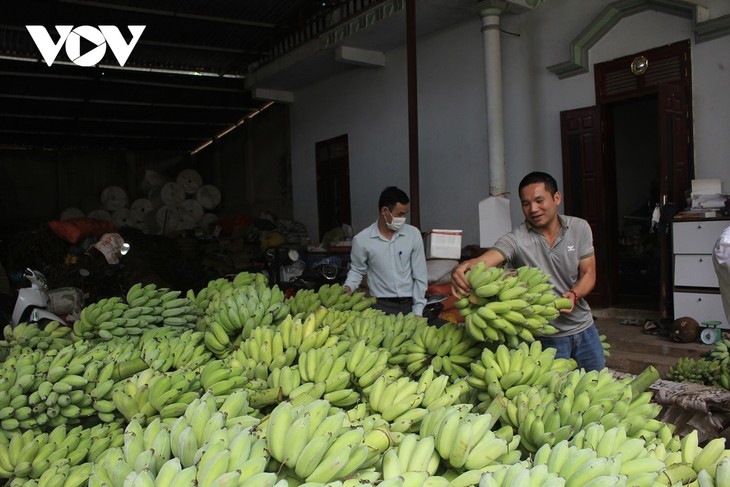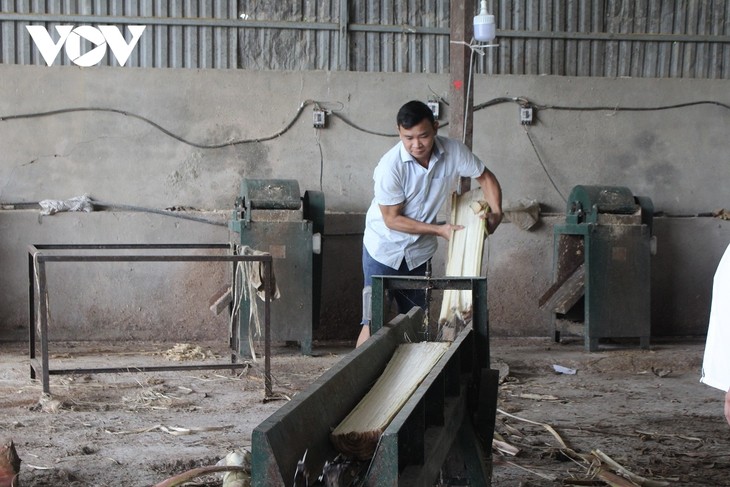(VOVWORLD) - Thick banana trees have been associated with the people of Muong La district, Son La province, for years and have stabilized their incomes and lives. In recent years, Muong La thick bananas have penetrated new markets, thanks to the locals’ dynamism and creativity. New products have been made from the tree trunks, opening new livelihoods for the locals.
 Manh Khoi Agricultural Cooperative is purchasing thick bananas for sales at the domestic market and exports. Manh Khoi Agricultural Cooperative is purchasing thick bananas for sales at the domestic market and exports. |
Lo Van Dinh’s family in Cup hamlet has 3 hectares of thick banana trees.
The tree, according to Dinh, isn’t picky about soil or terrain, and is easy to grow and take care of. This type of banana is less susceptible to insect pests, requires a smaller initial investment, thrives in local conditions, and provides in a stable income.
“Income from bananas is higher than from growing cassava or corn. When the price is high, it sells for 34 cents a kilo. On average, it sells for 13 cents a kilo. We can sell 500 to 600 kilos a month. If bananas go for a good price, my family can earn up to 300 USD a month,” said Dinh.
After harvesting, the commune’s banana growers carry their fruit to the Manh Khoi Agricultural Cooperative, which sells bananas and banana-based products to the domestic and international market.
Pham Thi Thuy, a Cooperative member, said, “Every 3 days we harvest about 15 tons of bananas to sell to Nghe An and Ha Tinh province. The moon is full, we can sell more than 20 tons. The Cooperative just exported a consignment to the European Union.”
In addition to the bananas, Muong La farmers make money from selling the banana leaves, flowers, and stems. Banana leaves are sold to businesses who make pork pies or packed rice cakes. Banana flowers are sold to restaurants to flavor their dishes. The stems of the banana trees are used as cattle feed.
 Ca Van Mua in Muong La district has invested in a production line to produce fibre from banana trunks. Ca Van Mua in Muong La district has invested in a production line to produce fibre from banana trunks. |
Recently Ca Van Mua’s household business in Muong Bu commune has invested in a production line to produce fibre from banana trunks, opening a new direction for this crop in Muong La.
Mua said the idea came from the abundant potential of the local material areas. Mua’s family buys banana trunks from villagers at 21 cents for 1.2 meters and prefers trees with multiple bunches, which usually produce stronger fibres.
“The banana fibre is sold to wholesalers in Hanoi and Lao Cai for 7.7 USD a kilo for type 1 and for 5.4 USD a kilo for type 2. Last month I sold 1.5 tons of raw yarn, earning nearly 8,200 USD. We plan to introduce samples in India. If it meets their requirements, we’ll buy another 50 machines for production,” according to Mua.
Muong La district has 1,300 hectares of bananas, mainly in the communes of Muong Bu, Muong Chum, Chieng San, Ta Bu, and Chieng Lao, and in It Ong town. The annual fruit yield is 10,000 tons.
Nguyen Van Tam, Vice Chairman of the Muong La People's Committee, said the district is coordinating with the Son La sub-Department of Plantation and Plant Protection and the Department of Cultivation of the Ministry of Agriculture and Rural Development to build 4 growing area coded for banana trees to meet export requirements.
Muong La is also building areas of organic bananas grown in line with VietGAP standards, branding them, and promoting the Muong La banana brand to boost the profits of the local farmers.
“Our bananas will be exported to the EU and other countries once we meet their standards. Banana fibre is in demand in the African and Indian markets,” Tam said, adding, “After the initial trial, if the new products meet market requirements, the district will expand the banana growing area to 2,000 to 2,500 hectares, and take advantage of the land to grow bananas.”
The new directions plus new products made of thick banana tree are helping cover the barren hillsides and slopes in Muong La district with green while local farmers have a stable income and get rich in their homeland.